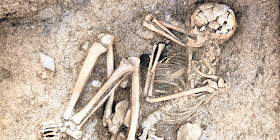Ach! What a way to go. Poor dude from the Chalcolithic age (yeah, I said the same thing - what the heck is that?) bled to death. The "in plain English, please" name for Chalcolithic age is the Copper Age. That "age" varies, depending upon the location of the civilization, as the use of metal-working spread from place to place. In this case, in Turkey, the generally accepted dates are Early Chalcolithic Period (5500 - 4500 BCE.); Middle Chalcolithic Period (4500 - 4000 BCE.); Late Chalcolithic Period (4000- 3000 BCE.
The tumulus (burial mound) where the body was excavated dates as far back at c. 8000 BCE.
From todayszaman.com (Turkey)
Tumulus skeleton found with arrow tip in spine
09 December 2010, Thursday / TODAY’S ZAMAN, İSTANBUL
The body of a man with an arrow tip still lodged in his spine was found during ongoing excavations in Bursa’s Aktopraklık tumulus. Archeologists believe that the man had died shortly after he was shot with an arrow from a bowman on higher ground. The tumulus where the skeleton was buried is estimated to have a history of about 8,500 years.
“This tomb of a man in his 30s from the early Chalcolithic period did not seem unusual at first glance. He was buried in accordance with the burial traditions of the period. … On closer examination of the skeleton, we discovered a deep arrow wound in the bottom of his spine,” paleoanthropologist Songül Alpaslan Roodenberg from the excavation team told the Anatolia news agency. “The arrow tip explained the cause of this Aktopraklık man’s death almost precisely,” she said.
Roodenberg also noted that the arrow tip was made of flint and it was lodged 12 millimeters into the spine. “It is most likely that the arrow struck his spine and damaged the abdominal aorta, which was located near the path of the arrow. This indicates that the man died shortly after he was injured [via the arrow],” she explained.
Adding that it is very probable that the man died quickly due to excessive bleeding, the paleoanthropologist said: “It seems that he was injured not far from the village and was taken back to the village shortly after he died. Otherwise, it would have been impossible for him to be buried in the traditional fetal position. “Although it is hard to tell whether the man was a warrior, hunter or just a peasant, this finding will certainly attract attention in the near future,” she added.
Roodenberg also noted that the tumulus, whose history stretches back to about 8,500 years ago, is one of the earliest farming villages. Nearly 60 tombs have been discovered during excavations at the ancient site, which were launched seven years ago with the support of the Bursa Metropolitan Municipality. The tombs are from the Neolithic and Chalcolithic periods.
“Rites for burying the dead give us clues about the belief systems of prehistoric people. Details including the shape of the tombs, the way the bodies are positioned or objects buried near the dead reveal much information,” she added.

No comments:
Post a Comment